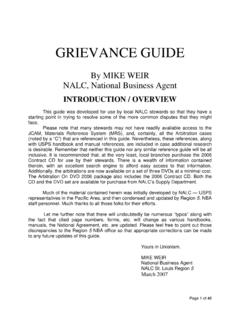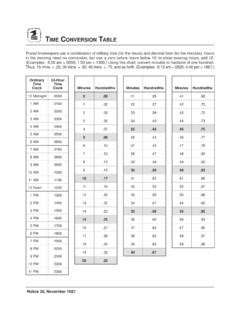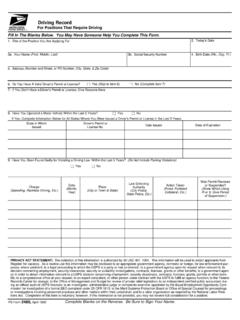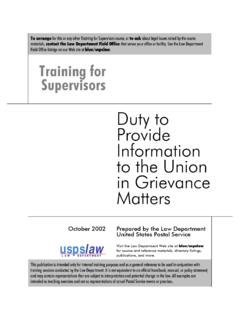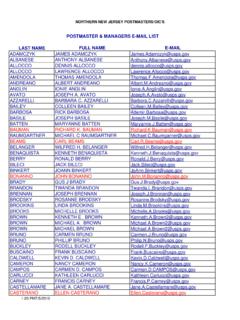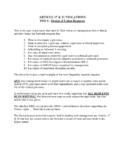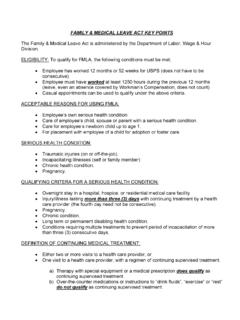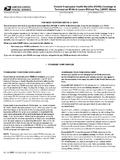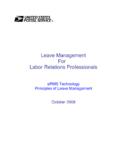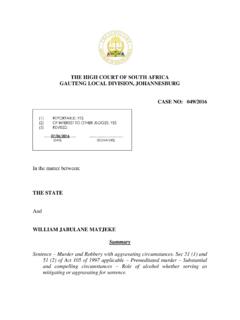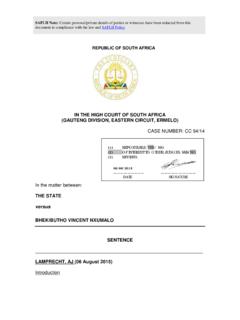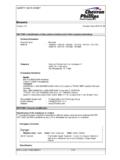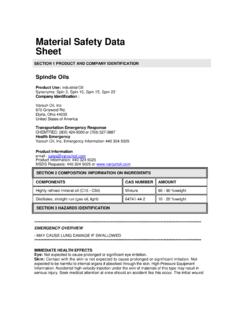Transcription of Douglas Factors In Depth - branch38nalc.com
1 Douglas Factors In Depth The Merit Systems Protection Board in its landmark decision, Douglas vs. Veterans Administration, 5 MSPR 280, established criteria that supervisors must consider in determining an appropriate penalty to impose for an act of employee misconduct. These twelve Factors are commonly referred to as Douglas Factors and have been incorporated into the Federal Aviation Administration (FAA) Personnel Management System and various FAA Labor Agreements. The following relevant Factors must be considered in determining the severity of the discipline: (1) The nature and seriousness of the offense, and its relation to the employee s duties, position, and responsibilities, including whether the offense was intentional or technical or inadvertent, or was committed maliciously or for gain, or was frequently repeated; (2) The employee s job level and type of employment, including supervisory or fiduciary role, contacts with the public, and prominence of the position; (3) The employee s past disciplinary record; (4) The employee s past work record, including length of service, performance on the job, ability to get along with fellow workers, and dependability; (5) The effect of the offense upon the employee s ability to perform at a satisfactory level and its effect upon supervisors confidence in the employee s work ability to perform assigned duties.
2 (6) Consistency of the penalty with those imposed upon other employees for the same or similar offenses; (7) Consistency of the penalty with any applicable agency table of penalties; (8) The notoriety of the offense or its impact upon the reputation of the agency; (9) The clarity with which the employee was on notice of any rules that were violated in committing the offense, or had been warned about the conduct in question; (10) The potential for the employee s rehabilitation; (11) mitigating circumstances surrounding the offense such as unusual job tensions, personality problems, mental impairment, harassment, or bad faith, malice or provocation on the part of others involved in the matter; and (12) The adequacy and effectiveness of alternative sanctions to deter such conduct in the future by the employee or others. A supervisor is responsible for ensuring that a disciplinary penalty is fair and reasonable.
3 If a penalty is disproportionate to the alleged violation or is unreasonable, it is subject to being reduced or reversed even if the charges would otherwise be sustained. These Factors provide valuable assistance to supervisors in making a penalty determination. Some of these twelve Factors may not be pertinent in a particular case. Some Factors may weigh in the employee s favor while other Factors may constitute aggravating circumstances that support a harsher penalty. However, it is critical to balance the relevant Factors in each individual case and chose a reasonable penalty. There is no requirement in law, regulation or in Douglas that written agency decisions or proposals contain specific, detailed information demonstrating that an agency has considered all of the pertinent mitigating Factors in a given case. However, a penalty determination will be entitled to greater deference if the proposal and especially the decision letter contain an evaluation of any mitigating circumstances.
4 It is always better for the Agency to do its own mitigating analysis than to leave it to a third party. In regards to any aggravating Factors , which may be relied upon to impose an enhanced penalty, these aggravating Factors should be included in the proposal notice. This is especially true for prior disciplinary actions. It is only fair to allow the employee to respond to these aggravating Factors before a decision is made. Consideration of aggravating Factors not communicated to the employee is dangerous and may result in a procedural error and reversal of the disciplinary action. Factor 1 Seriousness of the Offense The reason why this factor is first is simple - it is the most important. In determining the appropriate penalty, a supervisor should consider primarily the nature and seriousness of the misconduct and its relation to the employee s duties, position, and responsibilities. This Douglas Factor provides some guidance in determining the seriousness of an offense.
5 In evaluating the seriousness of the misconduct, an offense is more severe if it was intentional rather than inadvertent and if it was frequently repeated rather than being an isolated incident. Misconduct is also considered more severe if it is done maliciously or for personal gain. The agency s table of penalties provides some distinction regarding the severity of the misconduct. For example, sleeping on duty is a serious offense. However, it is considered more serious as provided in our table of penalties where safety of personnel or property is endangered. Moreover, the seriousness of the offense is increased if the employee is involved in what might be described as pre-meditated sleeping on duty. What does that mean? If you discover an employee sleeping away from his/her duty station with the lights off, pillow in hand and blanket over body, this intentional action is much more egregious than an employee who just cannot keep his/her eyes open and falls asleep while on position.
6 There are other examples in the table of penalties that provide guidance in determining the seriousness of misconduct. Misconduct of a sexual nature is a serious offense. However, the severity is increased when the misconduct involves physical touching or promising benefits in exchange for sexual favors in comparison to telling a sexual joke or making a sexual remark inappropriate to the workplace. Sexual jokes are more serious if made directly to an employee rather than if overheard by an employee. The misconduct is even more grievous if the jokes were repeated after the offender was told that the behavior was offensive. The relationship of the misconduct to the employee s job duties is another important consideration in determining the seriousness of an offense. Falsification of government documents is a serious offense because it relates to an employee s reliability, veracity, trustworthiness, and ethical conduct. The misconduct is more serious if it relates to the heart of an employee s duties and responsibilities.
7 For example, if a Time and Attendance (T&A) Clerk was falsifying his/her time and attendance records and it resulted in more pay or less leave used, this misconduct is very serious. The fact that accurate time and attendance records are a critical element of the employee s position, coupled with the fact that the misconduct resulted in personal gain, increases the gravity of this offense. The misconduct would be considered even more serious if the falsification was not an isolated incident, but reflected falsification over several pay periods. The supervisor deciding the appropriate penalty is in the best position to determine the seriousness of the offense and how the misconduct relates to the employees duties, position, and responsibilities. Remember, an offense is more serious if it is intentional, frequently repeated, or committed maliciously, or for personal gain. Factor 2 The Employee s Position This factor recognizes a relationship between the employee s position and the misconduct.
8 Factors considered are the employee s job level and the type of employment which may include a supervisory or fiduciary role, contacts with the public, and prominence of the position. It is a well-recognized principle that a supervisor occupies a position of trust and responsibility and is held to a higher standard of conduct than non-supervisory employees. The Agency s Standards of Conduct, outlines the responsibility for a supervisor to provide positive leadership and serve as a role model for their subordinates by demonstrating a commitment and sense of responsibility to their job and loyalty to the organization. Simply put, the Federal Aviation Administration (FAA) expects a supervisor to serve as a role model and not violate workplace rules. When misconduct occurs by a supervisor it is considered more serious. The Agency s table of penalties recognizes this severity in establishing ranges of penalties for supervisors and non-supervisors for offenses under the Discrimination/EEO/Misconduct of a Sexual Nature category.
9 An employee s supervisory status must be considered in determining the penalty for other offenses as well. Higher ethical standards are not limited to supervisory positions. Employees who hold law enforcement or security positions are also held to higher ethical standards. Employees of the Internal Revenue Service are held to a higher standard of compliance with Federal tax laws. Employees who exercise discretion in regulating, contracting or otherwise conducting government business with private companies are subject to stricter limits in the areas of gifts, gratuities, and conflicting financial interests regarding the companies with which they conduct official business. And if a member of Congress engages in , bad example, let s not go there. An employee s contacts with the public as well as the prominence of his/her position are additional considerations, which should be evaluated in relationship with the misconduct. And we must not forget the important element of safety in many of our positions and any misconduct must be weighed against this critical agency mission.
10 To summarize, the relationship between the employee s misconduct and the employee s position is an important consideration, which must be analyzed as part of the penalty determination. Factor 3 - Prior Discipline The Douglas criteria are sometimes referred to generally as mitigating Factors . The consideration of past discipline, however, is an aggravating factor, mitigation in reverse. In order to use prior discipline as a basis to enhance a current penalty, three criteria must be met. First, the employee must have been informed of the action in writing; second, the employee must have been given an opportunity to dispute the action by having it reviewed, on the merits, by an authority different from the one that took the action; and third, the action must be a matter of record. In deciding to use prior discipline, individuals must be aware of the Gregory decision, which held that prior discipline that is the subject of an ongoing appeal may not be used to support an enhanced penalty.
